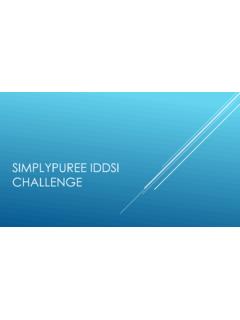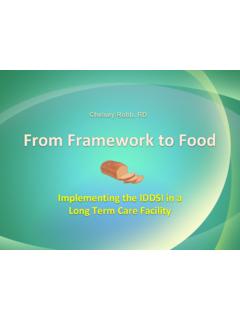Transcription of Drinks: Levels 0-4
1 This work is licensed under a Creative Commons Attribution-Non Commercial-No Derivatives International License September 25, 2015 1 Detailed Descriptors, Testing Methods and Evidence Drinks: Levels 0-4 This work is licensed under a Creative Commons Attribution-Non Commercial-No Derivatives International License September 25, 2015 2 INTRODUCTION The International Dysphagia Diet Standardisation Initiative (IDDSI) was founded in 2013 with the goal of developing new global standardised terminology and definitions to describe texture modified foods and thickened liquids used for individuals with dysphagia of all ages, in all care settings, and all cultures. Three years of ongoing work by the International Dysphagia Diet Standardisation Committee has culminated in a final dysphagia diet framework consisting of a continuum of 8 Levels (0-7).
2 Levels are identified by numbers, text labels and colour codes. This document provides detailed descriptors for the 5 Levels of drinks in the IDDSI Framework ( Levels 0-4). Descriptors are supported by simple measurement methods that can be used by people with dysphagia or by caregivers, clinicians, food service professionals or industry to confirm the level of a drink. The IDDSI Committee would like to acknowledge the interest and participation of the global community including patients, caregivers, health professionals, industry, professional associations and researchers. We would also like to thank our sponsors for their generous support. The IDDSI Committee: Co-Chairs: Peter Lam (CAN) & Julie Cichero (AUS); Committee Members: Jianshe Chen (CHN), Roberto Dantas (BRA), Janice Duivestein (CAN), Ben Hanson (UK), Jun Kayashita (JPN), Caroline Lecko (UK), Joe Murray (USA), Mershen Pillay (ZAF), Soenke Stanschus (GER), Catriona Steele (CAN).
3 The International Dysphagia Diet Standardisation Initiative Inc. (IDDSI) is an independent, not-for-profit entity. IDDSI is grateful to a large number of agencies, organizations and industry partners for financial and other support. Sponsors have not been involved with the design or development of the IDDSI framework. Gold Sponsor 2013-2015 Silver Sponsors 2013-2015 2013-2015 2015 This work is licensed under a Creative Commons Attribution-Non Commercial-No Derivatives International License September 25, 2015 3 Evidence and Measurement Evidence A systematic review of the literature was conducted to examine the impact of drink thickness and food texture on swallowing behavior across the age spectrum (Steele et al.)
4 , 2015 Dysphagia, 30(1): 2-26). With regards to liquids, the results of the systematic review determined: Thicker liquids reduce the risk of penetration aspiration, but also increase the risk of post-swallow residue in the pharynx The literature was insufficient to support the delineation of specific viscosity boundaries or other quantifiable material properties related to these clinical outcomes Of the 36 studies that met the eligibility criteria for the systematic review, 26 related to function in healthy populations whilst only 10 were related to individuals with dysphagia. Of these 10 studies, one related to infants and the remainder investigated swallowing function in adults with neurological or neurogenic conditions, or dysphagia associated with treatment for oropharyngeal or nasopharyngeal cancer.
5 The results of IDDSI s international stakeholder surveys demonstrated common use of thin drinks plus three Levels of increasing drink thickness for the management of swallowing problems across the age spectrum. The systematic review also found research investigating the impact of thickened drinks according to this general framework ( , thin drinks plus three Levels of increasing thickness) and described using labels previously found in previous national terminologies such as Nectar/Syrup/Level 150/Mildly thick; Honey/Custard/Level 400/Moderately thick and Pudding/Spoon thick/ Level 900/Extremely thick (Steele et al., 2015, Dysphagia, 30(1): 2-26). In addition, paediatric stakeholders reported common use of a drink thicker than water but thinner than the commencement point of thickened liquids commonly used for adults.
6 This level has been incorporated into the IDDSI Framework as Level 1 Slightly Thick. Level 1 Slightly thick drinks has also been verified as distinct from other thickness Levels in the literature, however, as with all other thickened liquids, this level lacks data to determine the exact thickness required for therapeutic benefit. Given the paucity of research regarding therapeutic thickness Levels for thickened drinks, the IDDSI framework is based on an understanding that increasing thickness has a demonstrated therapeutic benefit for reducing the risk of penetration/aspiration. The number of Levels of drink thickness included in the framework and recommended for best practice is based on clinical experience, stakeholder consensus and expert opinion.
7 The systematic review points to an urgent need to conduct quality research to determine thickness Levels that provide therapeutic benefit by reducing risk for penetration/aspiration and/or improving swallowing function. This work is licensed under a Creative Commons Attribution-Non Commercial-No Derivatives International License September 25, 2015 4 Measurement Accurate measurement of fluid flow properties is a complex task. To date, both research and existing national terminologies, have studied or recommended the classification of drinks based on viscosity. However, viscosity measurement is not accessible to most clinicians or caregivers. Furthermore, viscosity is not the only relevant parameter: the flow of a drink as it is consumed is influenced by multiple other variables including density, yield stress, temperature, propulsion pressure and fat content (O Leary et al.)
8 , 2010; Sopade et al., 2007, Sopade et al., 2008a,b; Hadde et ,b). The systematic review demonstrated wide variability in testing techniques used and found that other key parameters such as shear rates, sample temperature, density and yield stress were rarely reported (Steele et al., 2015; Cichero et al., 2013). Drinks thickened with different thickening agents may have the same measurement of apparent viscosity at one particular shear rate, and yet have very different flow characteristics in practice (Steele et al. 2015; O Leary et al.,2010; Funami et al., 2012; Ashida et al., 2007; Garcia et al., 2005). In addition to variations in flow associated with drink characteristics, flow rates during swallowing are expected to differ depending on a person s age and level of impairment of swallowing function (O Leary et al.
9 , 2010). For these reasons, a measurement of viscosity has not been included in the IDDSI descriptors. Instead, a gravity flow test using a 10ml slip tip syringe has been chosen by IDDSI as a practical objective measure to classify drinks based on their rate of flow. The controlled conditions are broadly representative of drinking through a straw or beaker. Although the equipment is simple, it is already internationally standardised and the IDDSI Flow Test has been found to categorise a wide range of liquids reliably, in agreement with currently existing laboratory tests and expert judgement. It has been found to be sensitive enough to demonstrate small changes in thickness associated with change in serving temperature.
10 For extremely-thick drinks, which do not flow through a syringe in 10 seconds and are best consumed with a spoon, a Fork Test is recommended as a method for determining consistency. This work is licensed under a Creative Commons Attribution-Non Commercial-No Derivatives International License September 25, 2015 5 Evidence relating to Levels of thickness and an accompanying grading of evidence (NHMRC, 2000) is shown in the table below. Note: despite best efforts, this list is not exhaustive. We intend to continue to update this descriptors document over time as further research is conducted and reported. Variable Reference Grade of Evidence Investigations of Levels 0 Thin in the research literature As noted in Steele et al.




